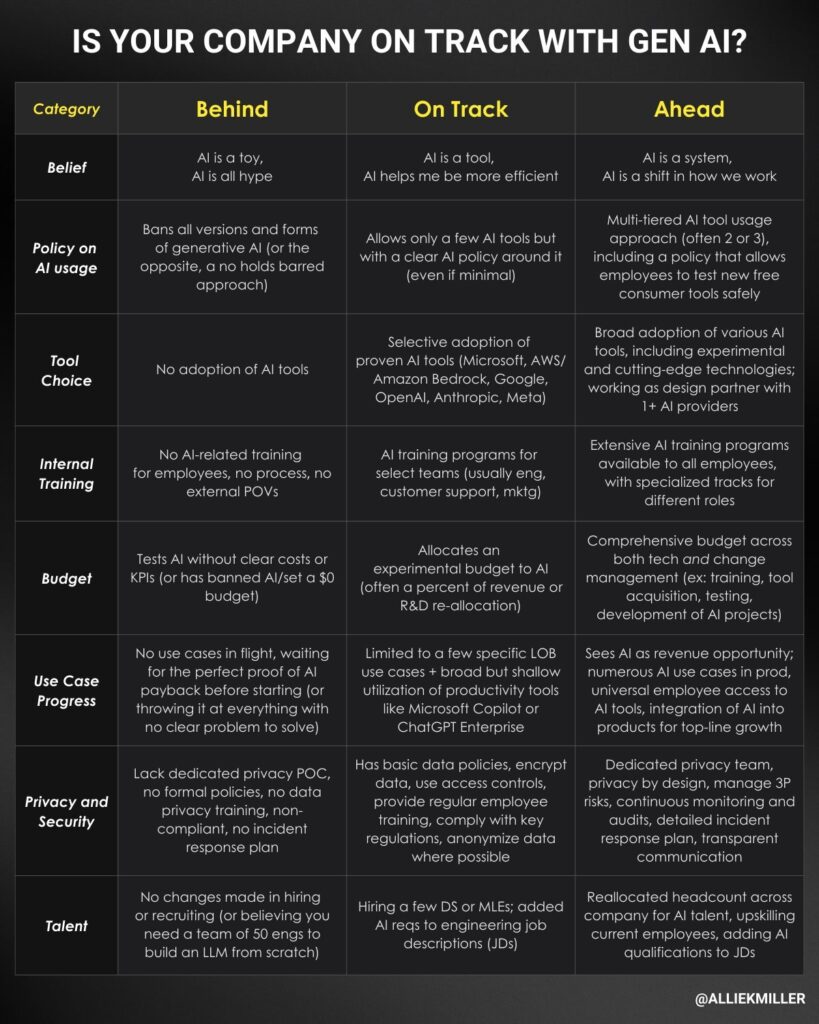Assessing Your Company’s Generative AI Readiness
In today’s rapidly evolving technological landscape, generative AI has emerged as a game-changing force across industries. But how can you determine if your company is keeping pace with this transformative technology? A recent chart by AI advisor and investor Allie K. Miller offers valuable insights into benchmarking your organization’s AI readiness.

Source: https://x.com/alliekmiller/status/1806049714166505721
The framework breaks down AI adoption into nine key categories:
- Belief: How does your company perceive AI? Is it seen as a mere toy, a useful tool, or a fundamental shift in work processes?
- Policy on AI Usage: What guidelines govern AI use in your organization? Are you banning all forms, allowing select tools, or embracing a multi-tiered approach?
- Tool Choice: Have you adopted AI tools, and if so, to what extent? Are you selectively using proven solutions or exploring cutting-edge technologies?
- Internal Training: How are you preparing your workforce for the AI revolution? Do you offer AI-related training programs?
- Budget: What financial resources are allocated to AI initiatives? Is there a dedicated budget for experimentation and implementation?
- Use Case Progress: How far along are you in deploying AI for practical business applications?
- Privacy and Security: What measures are in place to protect data and ensure compliance when using AI technologies?
- Talent: How is your hiring and workforce development strategy adapting to the AI era?
- Integration: To what degree is AI being incorporated into your products and services?
For each category, the chart outlines three stages of progress: “Behind,” “On Track,” and “Ahead.” This allows companies to pinpoint their current position and identify areas for improvement.
Key Takeaways:
- AI adoption is not binary. There’s a spectrum of implementation across various aspects of business operations.
- Being “On Track” doesn’t necessarily mean adopting every cutting-edge tool, but rather having a strategic approach to AI integration.
- Privacy, security, and responsible AI use are crucial components of successful adoption.
- Investing in workforce development and fostering an AI-positive culture are as important as the technical implementations.
- Companies should aim for a balanced approach, considering both the potential benefits and risks of AI adoption.
It’s important to note that this framework is a general guide. Your company’s optimal AI strategy may vary depending on your industry, size, and specific business needs. My goal would not necessarily be to stay “Ahead” in every category, but to find the right balance that drives innovation while managing risks effectively.
As you assess your company’s position, remember that the AI landscape is continually evolving. Regular re-evaluation and adaptation of your AI strategy will be key to staying competitive in the age of generative AI.


